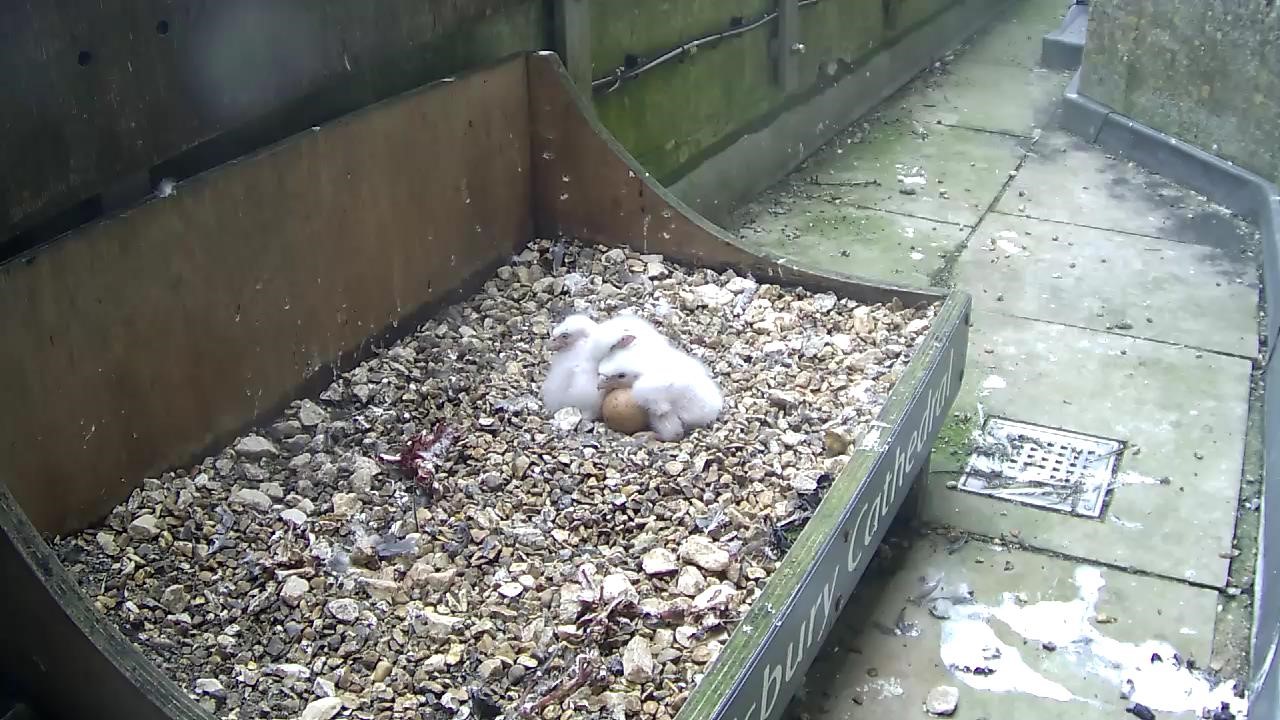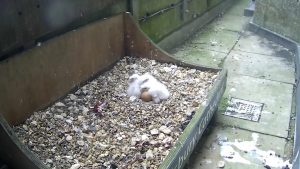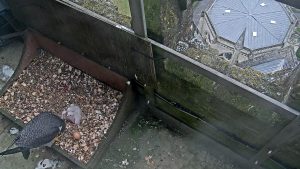Peregrine Blog 2023 – No 2

By Granville Pictor, 1 May 2023.
Readers of my previous blog will note that I predicted that our first egg this year would hatch ‘at around 23 April’. In the event the first egg hatched on the morning of 25 April’ what’re two days between friends!
The second egg hatched on the 26th and the third on the 27th. As I type this on 1 May, I have a nagging feeling that the fourth egg is not going to hatch; I hope I am wrong but it is four days since the last egg hatched. The female has not given up hope with it however, as this afternoon I watched her scoop the egg back under her breast to continue incubation.
On a warm afternoon today, when she was away from the nestbox for short periods the egg did not get cold as the three chicks several times fell asleep in a heap on top of it.

Apart from in 2017 when four of the five eggs laid failed to hatch for reasons not fully understood, we have been extremely lucky as in all other years all eggs laid at the Cathedral have hatched. The odd egg failing to hatch is in fact not at all uncommon in Peregrines, whether it is because the egg is infertile or perhaps the chick dies before breaking out of the egg.
There is a school of thought that suggests that perhaps it is associated with the adult female getting rather old as a breeding bird, but there seems to be no real consensus on this. As our adult female is unringed, we have no idea how old she is in any case. If the egg does not hatch it will be left in the nest either as a rather bleached and soiled egg once the other chicks fledge, or perhaps more likely be trodden on and broken by the other chicks as they grow.
Regular viewers of the nest cam will have seen the adult female pecking at the half-eggshells shortly after the chicks hatched. It is thought that perhaps this enables the female to replenish her calcium levels after egg laying. As with so many aspects of Peregrine breeding biology, however, as they say ‘the jury is still out’ on that one. Whilst I suspect the last egg may well not hatch, there have been instances elsewhere in the past where the last egg looks as though it was not going to hatch, has been left to one side and not actively incubated, and then has unexpectedly hatched…don’t hold your breath though!
In past years I have commented that when the chicks are very small, the adult male seems to bring in mostly small birds as prey items. Perhaps it is just when I have been watching the nest cam, but this year some really large prey items have been brought in, although quite what species of bird they have been I cannot say as they have been plucked and partially eaten before they were brought to the nestbox.

In the last couple of days, however, I have seen mostly smaller birds brought in, again mostly already plucked. My best guess from the size of the birds, their rather spindly legs and the odd feather on the nestbox, is that perhaps they were Starlings or Blackbirds.
Weather, and more specifically cold and wet weather, is a particular problem for young Peregrine chicks whilst still in their white non-waterproof chick down. This last week has mostly been cool with some rain, but our adults have been particularly diligent in keeping the chicks closely brooded to avoid any chilling.
There was a possible problem on the afternoon of 23 April when the heavens really opened and that part of the walkway covered by the larder nest cam was flooded; it took the best part of a day to drain completely. This flooding was caused by feather debris and general detritus blocking the metal cover over the walkway drain. Fortunately, the blockage was not as bad at the nestbox end of the walkway and there was no significant flooding.
When the chicks are ringed in about two weeks’ time we will clear the debris from the drain covers as a precaution. Speaking of the vulnerability of very young chicks, I gather from Cathedral staff that several people did contact them worrying that the smallest chick, presumably the last to hatch, did not seem to be getting fed as much as the two larger chicks. This does seem to happen most years with the smallest chick seemingly struggling to get to the front of the food queue so to speak. This year I watched as the chick fell onto its back several times as it struggled to push past its larger siblings to beg for food. In the end, it always seemed to succeed in getting a few mouthfuls, and as I type it looks strong and healthy and is almost as large as the two other chicks. Speaking of feeding, isn’t the addition of sound on the nestbox camera terrific? I had not realised until this year that the parents can be very vocal with ‘chupping’ calls as they feed the chicks, even when the parent seems to have its mouthful with a morsel of food to feed the chicks.
Digressing slightly for a few moments, we have lived in our current house near the St Marks Avenue roundabout for almost 12 years, and in all of that time, until 8 April of this year, I had not heard or seen a House Sparrow in or from the garden. It has been a bit of a standing joke amongst my birdwatching friends! Anyway, on said date, I finally heard and saw one, and on 16 April I saw three. A friend who helps edit the newsletter of the Wiltshire Ornithological Society ( a steal at £15 per annum subscription I might add) suggested I write a short note on birds seen in and from my city garden. So today, on a fine and sunny afternoon, I sat out on the patio, with a cup of coffee and my binoculars of course, and thought about what I might write.
With a lifelong interest in raptors and still reasonable eyesight given my advancing age, I was soon sidetracked by identifying tiny black dots high in the sky. Some could just about be seen with the naked eye, others were only found by scanning the sky with 10 times magnification binoculars. It was not long before a Peregrine was spotted high in the sky and in the general direction of the Cathedral. It was quite a slight bird in adult plumage, and I tentatively identified it as probably the adult male from the Cathedral.
It circled for about ten minutes before drifting off to meet up with a second bird. This bird was about the same size, but when the sun briefly lit it up when it banked, it has a brownish look to it and thus was identifiable as a second calendar male, ie one fledged in 2022. They circled together for a few minutes before the younger bird headed off high over towards Laverstock engaging in a number of spectacular dives as it went; it seemed to be enjoying the thermal lift provided by the fine weather.
About ten minutes later I heard a distant but familiar ‘chupping’ sound clearly from a Peregrine. It is a very similar sound as made by the adults when feeding the chicks, but I have mostly heard it in the past made by an adult falcon when intercepting an intruding falcon which has entered into its territorial airspace. I could not immediately see the bird responsible, but with a bit of scanning I located an adult male, probably the Cathedral male, high over the garden seemingly shepherding a larger female Peregrine off to the north over towards Old Sarum. A quick look at the Cathedral webcam confirmed that our female was still at the nestbox, so this was a second female.
It just goes to show that there are probably quite a few ‘spare’ falcons in the general area at any one time, some of which would probably happily move in to occupy the Cathedral site if one of our current birds went missing. We all remember Sally and the second adult female at the Cathedral a few years back and the problems that caused!
There is something about identifying tiny black dots in the sky, particularly of course if they are Peregrines. The late Derek Ratcliffe in his superb monograph on the Peregrine Falcon wrote that ‘Mortimer Batten (1923) has summed it all up for me’. Batten wrote ‘I remember in my childhood seeing or rather recognising my first Peregrine as he glided through immeasurable space among the clouds, and never in all of my life can I recall having witnessed anything in Wild Nature which left an impression so indelible and so full of romance as that small black cross against the sky’ Purple prose indeed but so very true. I saw my own first Peregrine almost 50 years ago at Woody Bay in Devon. In those days the bird was extremely scarce in southern England. Whilst I was on the beach it glided out from the top of a towering cliff, circled briefly and glided away around the adjacent headland. It was all over in less than a minute but I can recall it as if it were just yesterday. Such is the alure of the bird.
Happily, the fortunes of the Peregrine have improved in southern England in a big way since then, and the webcam now gives us a view of family life at the nestbox which could only have been dreamed of 50 years ago.
Our Cathedral chicks should grow very quickly, and as mentioned in my previous blog, we plan to ring them on 17 May when they will be given a metal British Trust for Ornithology (BTO) ring and a coloured Darvic ring. I dare say the chicks, as in past years, will all be given names on that date too.
The theme of the names has yet to be announced to the best of my knowledge, but given the significance of the year 2023 some viewers of the nest cam might think they can make an educated guess………….we shall see.




